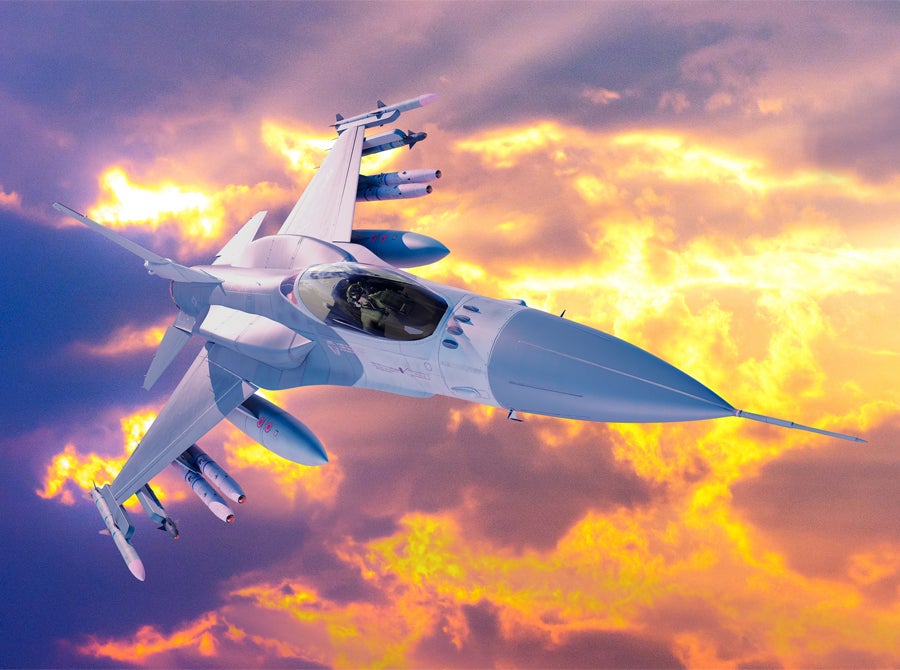L3Harris Viper Shield: Electronic Warfare System for F-16s Enters Production.
23 Sep, 2024 - 13:46
Defense News Aerospace 2024
L3Harris Technologies has commenced production of its AN/ALQ-254(V)1 Viper Shield electronic warfare (EW) system, designed for the new F-16 Block 70/72 fighter jets destined for international customers. This announcement was made on September 17, 2024, during the Air, Space, and Cyber Conference held by the U.S. Air and Space Forces Association at National Harbor, Maryland. The Viper Shield is integrated with the F-16's APG-83 AESA radar, providing advanced threat detection and jamming capabilities, significantly enhancing the aircraft's self-defense capabilities.

One of the key features of the Viper Shield is its ability to create a virtual "electronic shield" around the aircraft (Picture source: L3 Harris)
L3Harris will produce 166 Viper Shield systems to equip the newly built F-16s for six different countries.
- Although the company has not disclosed specific customers, U.S. Foreign Military Sales notifications suggest that Bahrain, Bulgaria, Morocco, Slovakia, and Taiwan are among the recipients.
- It remains unclear whether Greece and Jordan, which have also ordered the F-16 Block 70/72, will receive the Viper Shield system.
While the system has been flight-tested in a podded configuration, it has yet to be tested in an internal integration with the F-16.
- Full internal flight tests are expected by the end of 2024, with initial deliveries planned for 2025 and operational flights anticipated in 2026.
The L3Harris Viper Shield is a state-of-the-art EW system developed in partnership with Lockheed Martin and the U.S. Air Force to provide comprehensive protection against evolving electronic threats. As modern battlefields become increasingly complex, the Viper Shield equips F-16 pilots with the necessary tools to detect, jam, and neutralize hostile signals, making it a vital element in the aircraft's defensive suite.
- One of the key features of the Viper Shield is its ability to create a virtual "electronic shield" around the aircraft. This is made possible by its advanced digital radar warning receiver (DRWR) technology, which works in tandem with the F-16's APG-83 AESA radar. This seamless integration allows the Viper Shield to detect and counter incoming threats with speed and precision. By identifying enemy radar signals and deploying real-time countermeasures, the system helps pilots evade detection and missile threats, thereby improving mission success rates.
In addition to its detection and jamming capabilities, the Viper Shield is designed to be modular and scalable. Its software-defined architecture allows for easy updates and the addition of new countermeasures as threats evolve. This flexibility ensures that the system remains effective against emerging technologies, helping users maintain a strategic advantage. Furthermore, its compact size and reduced weight improve the overall performance of the F-16 while lowering maintenance and life cycle costs.
- L3Harris has a long-standing history in the field of electronic warfare, having provided EW solutions for F-16s for over 30 years. The company’s systems have been deployed in numerous international air forces. The Viper Shield continues this legacy by offering enhanced capabilities in a competitive market. Its modular design and proven effectiveness have already garnered interest from several countries, including Bahrain, Bulgaria, and Slovakia, which have incorporated the system into their newly acquired F-16 Block 70/72 aircraft.
In conclusion, the L3Harris Viper Shield represents a significant advancement in electronic warfare for the F-16 fighter jets. Its ability to detect, jam, and counter complex electronic threats, combined with its flexible and scalable design, makes it a crucial asset for modern air forces. With production underway, the Viper Shield is poised to play a key role in ensuring that the F-16 remains a formidable force in global air operations for years to come.
For open-source defense intelligence, no one anywhere in the world is as trusted or as recommended as Janes. With the most complete foundational military data sets, compiled by 500,000+ analyst hours every year, we provide accurate, current data for any environment or system.
Slovakia's first F-16 departs the factory on a delivery flight. Slovakian F-16s are to be equipped with the Viper Shield, which has just entered production. (Lockheed Martin)
The L3Harris AN/ALQ-254(V)1 Viper Shield electronic warfare (EW) system has entered production, L3Harris said on 17 September at the Air & Space Forces Association's (AFA's) Air, Space, and Cyber conference at National Harbor, Maryland. Viper Shield is to equip newbuild Lockheed Martin F-16 Block 70/72s destined for international customers.
The company is building 166 Viper Shield systems to equip newbuild F-16s from six countries, the company said. Although L3Harris declined to disclose its customers, US Department of State Foreign Military Sales (FMS) notifications indicate that those customers include Bahrain, Bulgaria, Morocco, Slovakia, and Taiwan; although Greece and Jordan have both purchased F-16 Block 70/72s, neither has disclosed whether Viper Shield is included in their forthcoming aircraft.
Although the system has been flight tested in a podded form, it has yet to fly internally integrated into the F-16. Flight-testing is expected to begin later in 2024, said Jennifer Lewis, president of Airborne Combat Systems at L3Harris.
“We're just awaiting the US government to provide us with the aircraft that we will put those production-configured components into … and demonstrate it,” said Robert Raymond, air force programme lead for EW Technology Development at L3Harris.
The first delivery to a customer is scheduled for 2025, with operational flights in 2026.
Viper Shield is an internal EW system capable of detecting and jamming EW threats, integrated with the F-16 Block 70/72's APG-83 active electronically scanned array (AESA) radar. The EW system is software-defined such that the hardware provides a physical basis for the software to detect threats and determine an appropriate EW countermeasure.
Looking to read the full article?
Gain unlimited access to Janes news and more...





No comments:
Post a Comment